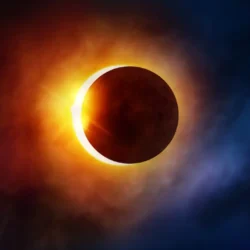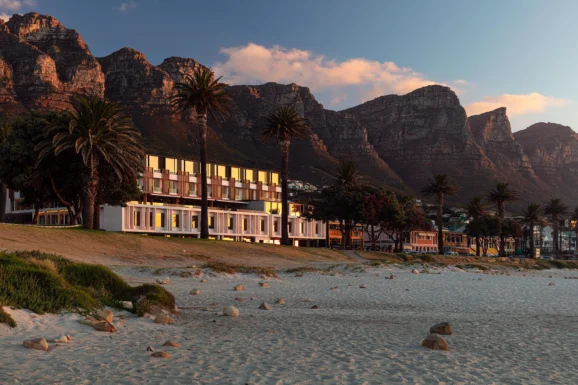Six Spectacular Sky Events to Watch in 2024

From sparkling meteor showers to a total solar eclipse, 2024 promises to be sensational for stargazers
According to Booking.com, there are six must-visit places where these celestial light shows can be viewed best from Earth.
Its list, published on Monday, includes destinations, accommodation and suggested activities and excursions in five continents across the world.
According to Booking.com, each one promises a “show-stopping”, front row seat.
There’s nearly a whole year’s worth of planetary phenomena left to observe, so here’s your chance to learn more about and plan for some of them.
1. Total Solar Eclipse (April 8) – Canandaigua, New York, United States
What: A total solar eclipse that stretches from Mexico to Canada. A must-see phenomenon that won’t happen in the US again until 2044.
Where: Astro-travellers can journey to the ‘path of totality’ where the moon will completely eclipse the sun and momentarily block out the light. In west-central New York state, the northern reaches of the Finger Lakes, home to narrow lakes, rolling hills and waterfalls, provide the perfect backdrop for this rare celestial event.
“On the afternoon of April 8, as the sun disappears, the darkened skies will move across the city of Canandaigua, located at the top of its eponymous lake, and offer travellers a stellar opportunity to experience the totality reflected on still water for nearly three minutes,” the Booking.com team said. The Finger Lakes is an outdoor paradise, as well as the state’s premier wine-growing region with more than 120 vineyards. Travellers can toast the eclipse on a Canandaigua Wine Trail, stopping at a curated selection of vineyards, wineries and tasting rooms to meet the makers and sample a variety of world-class wines.”
Where to stay: Experience the eclipse in all its glory at The Lake House on Canandaigua, which is hosting a viewing party for skywatchers complete with observation glasses, a keepsake blanket, canapes, cocktails and live entertainment. This luxe lakefront resort, located in the heart of the Finger Lakes region, features impeccably designed guest rooms, many with private balconies, and offers a myriad of amenities including a heated lakefront pool, hot tub and boating activities in the warmer months. Guests can enjoy fresh, locally sourced fare in the onsite Rose Tavern restaurant or visit Sand Bar for a beer and a burger.
2. Lyrids Meteor Shower (April 22-23) – Todra Gorge, Morocco
What: One of Earth’s oldest annual meteor showers, this celestial event peaks this year on April 22-23, when it will be possible to view 10-20 streaks per hour.
Where: The northern hemisphere is best for viewing this spectacular light show, and stargazers can head to the Todra Gorge in the Moroccan Sahara where they won’t have to worry about bright moonlight interference or light pollution. Nestled within the rugged terrain of the High Atlas Mountains, this geological wonder with its deep valleys forged from limestone has earned the nickname ‘Morocco’s Grand Canyon,’ and beckons nature enthusiasts and adventurers. Travellers can refocus their gaze from the skies back down to earth on an easy Half-Day Todra Gorges Hike, meandering through shaded riverside gardens, palm groves and crystal-clear rivers, or a 7 Days Hiking in Todra Gorge: All Inclusive will allow keen stargazers and trekkers to explore the gorge from all vantage points, from the vibrant souks of the oasis town of Tinerhir to the surrounding Berber villages on a trip that will take the stress out of vacation planning.
Where to stay: Enjoy mesmerizing views of the awe-inspiring landscape at the Auberge Le Festival Todra Gorge situated high in the Atlas Mountains, and a top spot for the meteor shower. Showcasing Morocco’s rich heritage, rooms are decorated in an authentic Berber style, and a traditional breakfast of handmade breads, cakes drizzled with honey and melted butter, and black olives is served each morning. Considered the main meal of the day, it’s sure to refuel guests after a night of stargazing, with other exciting activities such as rock climbing and off-road adventures accessible from the hotel.
3. Eta Aquarids Meteor Shower (May 6-7) – Coonabarabran, Australia
What: Debris created by Halley’s Comet will send meteors across Earth this year, peaking on May 6-7 with roughly 10-20 shooting stars visible per hour.
Where: While stargazers worldwide can see the showers, the Eta aquarids favour the southern hemisphere, and the Warrumbungle National Park, certified by the International Dark-Sky Association (IDA) for exceptionally starry nights, offers a first-class seat to these spectacular streaks. Situated in the Orana region of New South Wales, Warrumbungle is Australia’s first Dark Sky Park and a standout spot for camping under the stars (although travelers will need to book several months in advance). During the day, the park offers great hiking around its rocky, volcanic mountain and eucalyptus-dotted landscape. At night, the sky is like a jewel box thanks to strict measures to protect against light pollution. The town closest to the wilderness is Coonabarabran, known as the ‘astronomy capital’ of Australia. Here, astronomy enthusiasts can visit the Siding Spring Observatory to check out Australia’s largest telescopes or learn about the night sky at the Milroy Observatory.
Where to stay: Just a short drive to Coonabarabran and Warrumbungle National Park is the Pilliga Pottery Creative Farmstay. This eco-friendly gem has its own water supply and solar system, and is nestled on the edge of the pristine Pilliga Forest, a prime place to watch the meteor shower. Guests can choose between sleeping under the stars in the peaceful camping paddock, or bedding down in the secluded Poet’s Cottage or Farmhouse, with a large wooden veranda that overlooks the surrounding horse paddocks and hills. This beautiful bush stay features a salt-water swimming pool, barbecue facilities, pottery classes and an onsite cafe serving food from local producers including delicious homemade Pilliga ice cream.
4. Perseids Meteor Shower (August 11-13) – Joshua Tree, California, United States
What: One of nature’s greatest fireworks displays, the peak of the Perseids meteor shower this year will produce 50-100 streaks per hour at an average speed of 36 miles (58 km) per second.
Where: While the moon will be half full in mid-August, once it sets, skywatchers in lower latitudes north of the equator will have plenty of hours before dawn to enjoy this fireball frenzy. For prime observation, camp at Joshua Tree National Park, certified by the International Dark-Sky Association (IDA), and renowned for its cloudless skies and otherworldly beauty. Named after the native tree, this 794,000-acre (321,000-hectare) desert wilderness about a two-hour drive east of Los Angeles has a wealth to offer travellers. From prickly plants to car-sized boulders, the terrain is perfect for hiking, rock climbing and bird watching and offers surreal sunsets and sunrises. To stargaze with the pros, sign up for a Professional Stargazing in Joshua Tree for a night in the park using cutting-edge telescopes, or head out on a Private Stargazing and UFO Tour with special night-vision goggles and high-powered binoculars to catch a glimpse of planets, shooting stars, nebulae and other interstellar objects.
Where to stay: Guests can enjoy a nature-driven escape at the @ Marbella Lane – The Wine Mine Desert Escape, just a short walk to Joshua Tree National Park’s west entrance. This spacious four-bedroom vacation home is ideal for families and groups of friends, offering private parking and an outdoor dining patio with incredible mountain views and a hot tub, a perfect spot to view the Perseids shooting across the sky. Travelers looking to immerse in an oasis in the desert will wake up to the sound of chattering quail in the morning and spot coyotes, jackrabbits and desert tortoises from the property.
5. ‘Ring of fire’ Eclipse (October 2) – Hanga Roa, Easter Island, Chile
What: A ‘ring of fire’ annular eclipse crossing remote swaths of Argentina, Chile and Easter Island. During this celestial convergence, set to last around seven minutes, the moon will pass between the Earth and the sun, creating a surreal sun-flamed frame.
Where: The Booking.com team said: “For travellers looking for a once-in-a-lifetime trip, Easter Island, a remote South Pacific island off the coast of Chile scattered with hundreds of huge ancient stone statues, presents a mystical backdrop to the eclipse. With the landmass of the island blocking the prevailing wind, the destination offers good prospects of a clear sky and travellers can view the spectacle from the beach, or head to the ceremonial village of Orongo, a revered place on the edge of a spectacular volcanic caldera. Known as ‘Rapa Nui’ in Polyenesian, Easter Island and its main town of Hanga Roa brim with history, culture and nature. Delve into its archaeological mysteries on an Easter Island Moai Archaeology Tour: Ahu Akivi, Ahu Tahai and Puna Pauâ Quarry and learn about the logic-defying ‘moai’ statues which have captivated the world’s imagination for centuries.”
Where to stay: On a tree-lined road in Hanga Roa, the Hare Nua Hotel Boutique is just a short walk to both Pea Beach and the archaeological site of Ahu Tahai, prime spots where anyone can watch the eclipse. Covered in beautiful greenery, this calm retreat offers a wellness centre and spa, along with an outdoor wooden hot tub and pool, while warmly decorated rooms feature colourful Polynesian artwork. Guests can jump head first into the full Easter Island experience at this hotel, which makes a great base to explore and offers activities from trekking and horse riding to windsurfing and snorkelling.
6. Geminid Meteor Shower (Dec 13-14) – Glenmore, Cairngorms, United Kingdom
What: The Geminid meteor shower will be one of the most active astronomical displays to burn through the skies in 2024. A waxing gibbous moon will shine during the peak of this prolific meteor shower, but if skies are clear, stargazers will see around 120 shooting stars per hour.
Where: his celestial shower favours the northern hemisphere, and travellers can head to the world’s northernmost Dark Sky Park, home to some of the darkest and most magical skies. Located in the Scottish Highlands, the Tomintoul and Glenlivet Cairngorms Dark Sky Park has amazing vantage points and vast horizons, and visitors are in with the chance of a bonus performance in December with the swirling Milky Way and spectacular northern lights dancing across the skies. A Cairngorms National Park & Glenfiddich Distillery excursion will shine a spotlight on the park during the day, rounded off by a visit to a famous whiskey distillery, while a Private Guided Walking in Cairngorm Mountains tour will guide travellers to the summits of the highest peaks for panoramic views of this beautiful wilderness and the opportunity to spot darting red squirrels, soaring ospreys and golden eagles.
Where to stay: Situated in the heart of the Cairngorm National Park, the cozy Cairngorm Lodge Youth Hostel in Glenmore is a prime base for viewing the Geminid meteor shower and chasing the northern lights, with stunning views of the Northern Corries. A short walk to the Cairngorm Mountain Railway and snowsports area, and Loch Morlich fringed with sandy beaches and ancient pine forests, this dog-friendly stay is ideal for outdoor enthusiasts. Delicious cooked Scottish breakfasts, packed lunches and warming evening meals will fuel guests for adventure, while private rooms and dorms as well as bike storage and drying rooms are available.














